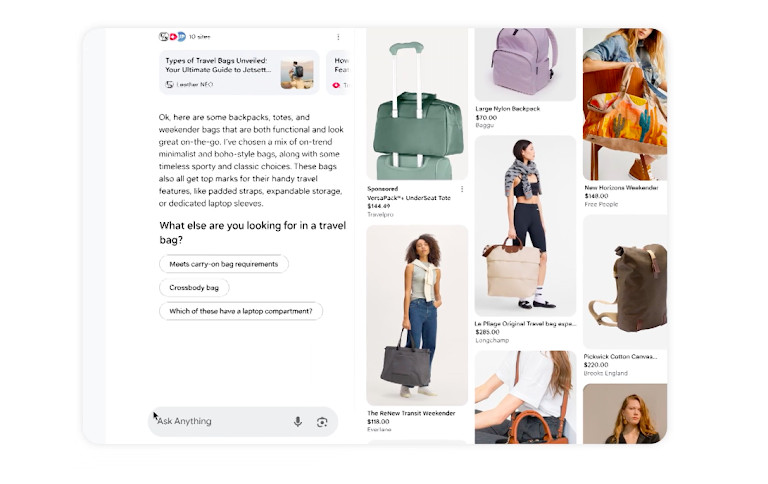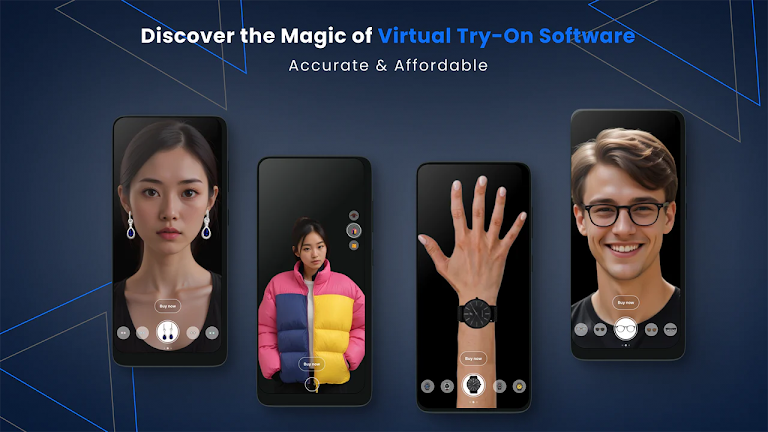Google’s AI Mode Lets Users Shop, Compare, And Try Clothes With Their Own Photos


In Brief
Google has introduced AI Mode, a Gemini-powered shopping feature that helps U.S. users explore product suggestions, track prices, and virtually try on clothes using their own image.

Google has introduced AI Mode, a new addition to its shopping tools designed to help users make better and faster buying decisions. With this update, shoppers can explore clothing, accessories, and other items with the help of intelligent suggestions, real-time pricing, and even a virtual try-on option that uses their own photo.
This new experience brings together AI-powered recommendations with extensive product listings to improve the way people shop online. The rollout begins in the United States and will gradually reach more users over time.
A More Flexible Way to Explore Products
AI Mode works as a personal assistant within Google’s shopping interface. Instead of simply typing in a product name and browsing endless pages, users can now explain what they need — and AI Mode takes care of the rest.
For instance, if someone mentions they’re looking for a bag that would suit rainy weather during a trip in May, the AI examines typical conditions for that time and location. Then it suggests weatherproof bags that meet those needs. The selection adjusts live, showing only relevant products based on filters like material, ease of access, or user reviews.

Behind the scenes, this system is supported by the Shopping Graph, which includes data from over 50 billion product listings. These listings are refreshed constantly, with Google noting that more than 2 billion updates happen every hour. This ensures shoppers always get up-to-date details about stock availability, discounts, and delivery estimates.
As users scroll through the results, the system adapts based on their behavior. It learns preferences like style, color, and price sensitivity, which helps shorten the time between searching and purchasing.
Gemini Makes Shopping More Context-Aware
One of the biggest advantages of AI Mode is how it uses Gemini, Google’s advanced language model. Gemini doesn’t just respond to keywords — it analyzes the intent behind each search.
Let’s say a user wants a “comfortable spring jacket for walking downtown.” Instead of pulling up every spring jacket in stock, Gemini considers comfort, weather, movement, and price. Then it recommends pieces that match the situation — like light, breathable fabrics, or jackets with practical pockets.
It also pays attention to habits. If a shopper tends to look at eco-conscious brands or prefers stores with flexible return options, that behavior influences future suggestions. This gives the shopping flow a more personalized feel, without needing users to manually adjust filters.
The result is a browsing experience that feels more intuitive and less like managing a search engine.
Smart Checkout That Knows When to Buy
AI Mode also adds a powerful tool called agentic checkout. With this feature, people can “bookmark” a product and let the system keep an eye on it. Once the price drops or matches the user’s target — and the preferred color or size is in stock — the system will notify them.
There’s also an option to skip the manual process. Users can set the system to “buy for me” once all their conditions are met. The tool will then complete the transaction using Google Pay, acting on the user’s behalf directly through the retailer’s site.
This function is designed to reduce missed opportunities, especially when items go out of stock quickly or during flash sales. It also benefits people who don’t want to check product pages every day.
The agentic checkout feature is launching first in the U.S., with more coverage expected later. It reflects a shift from traditional search-and-buy behavior to something more efficient and responsive.
Try-On Feature That Works with Your Own Photo
Among the most talked-about tools in AI Mode is its updated virtual try-on capability. This tool allows users to see how clothing would look on themselves — not just on models.
To use it, shoppers upload a full-body picture that meets certain requirements (neutral pose, good lighting, fitted clothing). Then the system overlays different garments on the image, showing how they might appear on their actual body shape.
This feature goes beyond simple image projection. It uses a custom AI model built by Google to understand how fabrics behave — including how materials fold, stretch, and interact with various body types. As a result, each outfit adjusts naturally to the user’s posture and size.
Right now, the feature works for tops, skirts, pants, and dresses. Additional categories may be added depending on user demand.
Users can also save different looks, share them with friends, or compare outfits before making a final decision. It’s especially helpful for people who aren’t sure how a trend might look on them or want to avoid high return rates.
Search Labs Access for Early Testers
This try-on technology is part of an early test phase through Search Labs. Users in the U.S. can already try it by selecting the “Try it on” button next to supported listings.
The tool lets users preview multiple products without needing to visit a physical store. It works best for visualizing fit, length, and cut — things that are often difficult to judge from static product images.
As it expands, this system could become a new standard in fashion e-commerce, especially as buyers continue to expect more confidence and accuracy from online shopping.
Google’s Plan to Simplify Shopping
Google’s AI Mode is meant to address the frustration many people feel when trying to shop online. From unclear size charts to sudden price changes and hard-to-compare options, online shopping often involves guesswork.
This update combines three main strengths:
- Product intelligence from the Shopping Graph;
- Smart interaction via Gemini;
- Personalized action tools, like price tracking and virtual try-on.
Together, they form a connected journey — from choosing an item to trying it on, setting a price goal, and completing the purchase automatically.
It’s not just about finding products anymore. It’s about removing friction at every step, while making the process more visual, flexible, and suited to real needs.
How Other Companies Are Transforming Shopping with AI
As Google introduces AI Mode, other big companies are also using AI to make online shopping easier, faster, and more personalized. Many of them focus on similar things — like showing how clothes look, helping people find the right size, or letting them track price changes automatically. Each platform has its own way of solving these problems.
Amazon’s AI Shopping: Virtual Try-On and Voice-Guided Help
Amazon, the world’s biggest online store, uses AI in several parts of its shopping process.
One of its popular tools is Virtual Try-On, which helps people see how shoes and glasses will look on them using augmented reality (AR). This tool works inside the Amazon app. A shopper can open their phone’s camera and see how a shoe or pair of glasses fits their face or feet, live on screen. The image adjusts in real time as they move.

Amazon also created Rufus, an AI helper that answers questions about products. People can ask things like “What’s a good gift for a coffee lover?” or “Which phone under $300 has the best battery?”. Rufus explains what each product does, highlights key reviews, and suggests items based on what the shopper needs. It gives answers in clear, natural language.
In 2025, Amazon said it would close its “Try Before You Buy” program, also known as Prime Wardrobe. The reason? New tools like Virtual Try-On and AI sizing features were doing the job better. This change shows that Amazon believes instant, AI-guided tools are more helpful than older shopping models.
Snapchat’s AR Commerce: Shopping Lenses That Make Try-On Fun
Snapchat, a social media app that focuses on photos and video, is using its camera tools to help people shop. The company has built AR Shopping Lenses, which let users try on clothes, glasses, makeup, and more — all through their phone’s camera.
These shopping lenses adjust to a person’s face or body in real time. They show how items look from different angles as the user moves. Big brands like Nike, MAC, and Prada already upload their catalogs so people can try their products virtually inside the app.

This method is not only fun, it works. Snapchat says that people are 11 times more likely to buy after using AR shopping lenses than from regular images. For many users, it feels more personal and natural than scrolling through product lists.
Snapchat’s approach turns shopping into something visual and interactive — not just a task.
Klarna’s AI Assistant: Smart Help With Chat and Photo Tools
Klarna, a Swedish tech company known for its buy-now-pay-later service, is also using AI to upgrade how people shop.
Inside its app, users can chat with an AI shopping assistant that helps them find what they need. They can ask for price comparisons, find similar items, or get alerts when a product goes on sale. This assistant remembers what the shopper likes and gives advice based on past behavior.

Klarna also has a tool called Shopping Lens. It lets users upload a picture of a product they’ve seen — maybe in real life or online. Then the AI searches for similar items they can buy. This turns visual inspiration into real options fast, without typing.
The company says that its AI system now does the same work as over 800 employees. This saves time and money while also helping customers get answers faster.
By combining chat and image tools, Klarna is trying to give shoppers what they want before they even know how to ask for it.
Shopify’s Try-On Features: Easy AI Add-Ons for Small Brands
Shopify, a platform that helps small businesses sell online, doesn’t build its own AI — but it gives store owners easy ways to use it. Merchants can add apps that offer virtual try-on and AI size matching, even if they don’t have a big team or budget.

Some of the most used apps include:
- OnYou – Customers upload a photo to try on clothing virtually. This helps them feel more confident and reduces returns;
- AI Stylist – Suggests sizes by guessing the customer’s measurements and comparing across brands;
- Camweara – Helps people try on glasses or jewelry and shows store owners which items get the most attention.
These tools make online shopping feel more like the real thing. They also give sellers data about what people are looking at — which can help with planning future collections.
For brands using Shopify, these AI apps give them access to smart technology without building it from scratch.
A New Era of AI Shopping: Personalized, Visual, and Instant
Across all of these platforms — from Google and Amazon to Snapchat, Klarna, and Shopify — AI is quickly becoming the core of the online shopping experience.
Each company is solving similar problems, just in their own way:
- Helping people find the right product faster;
- Making it easier to understand what an item really looks like;
- Tracking prices or sizing without doing it manually;
- Turning browsing into a smart, personalized flow.
As Lilian Rincon, Vice President of Product Management at Google, said:
“Our new AI Mode experience is built for every part of shopping — from finding inspiration to buying at the right moment. Plus, our virtual try-on tool now works with your own photos.”
This idea matches what many companies are moving toward. AI is no longer just an add-on — it’s becoming the brain behind how people shop.
And while Google’s AI Mode ties together search, visual try-on, and smart checkout in one flow, the rest of the industry is moving fast too. Together, these tools are changing how we think about buying online — from static pages to smart, responsive experiences that fit real life.
Shopping is becoming more human — powered by machines that understand us better.
Disclaimer
In line with the Trust Project guidelines, please note that the information provided on this page is not intended to be and should not be interpreted as legal, tax, investment, financial, or any other form of advice. It is important to only invest what you can afford to lose and to seek independent financial advice if you have any doubts. For further information, we suggest referring to the terms and conditions as well as the help and support pages provided by the issuer or advertiser. MetaversePost is committed to accurate, unbiased reporting, but market conditions are subject to change without notice.
About The Author
Alisa, a dedicated journalist at the MPost, specializes in cryptocurrency, zero-knowledge proofs, investments, and the expansive realm of Web3. With a keen eye for emerging trends and technologies, she delivers comprehensive coverage to inform and engage readers in the ever-evolving landscape of digital finance.
More articles

Alisa, a dedicated journalist at the MPost, specializes in cryptocurrency, zero-knowledge proofs, investments, and the expansive realm of Web3. With a keen eye for emerging trends and technologies, she delivers comprehensive coverage to inform and engage readers in the ever-evolving landscape of digital finance.


















































